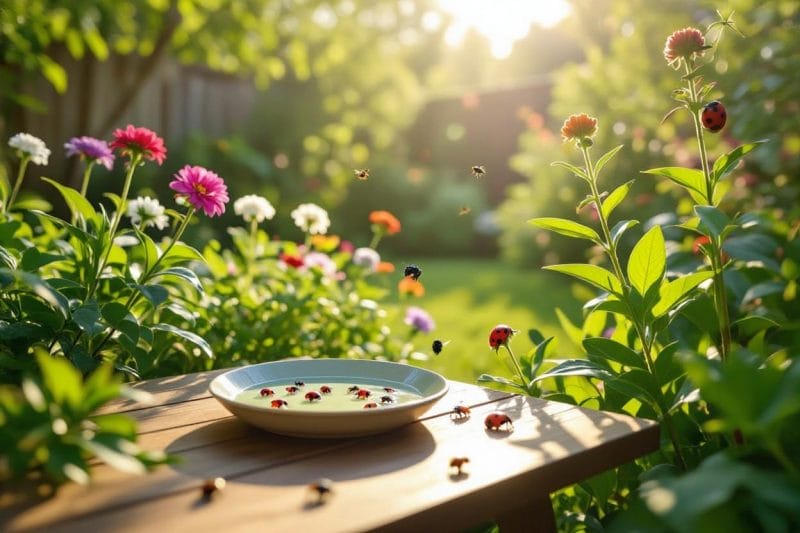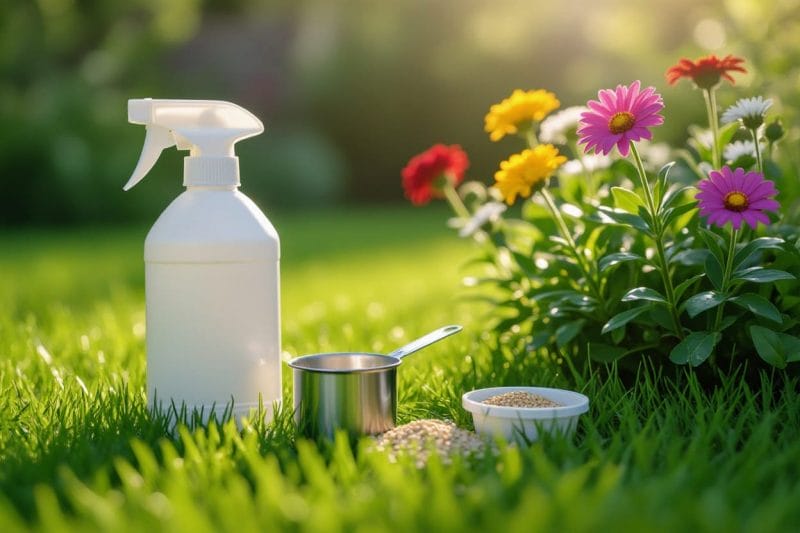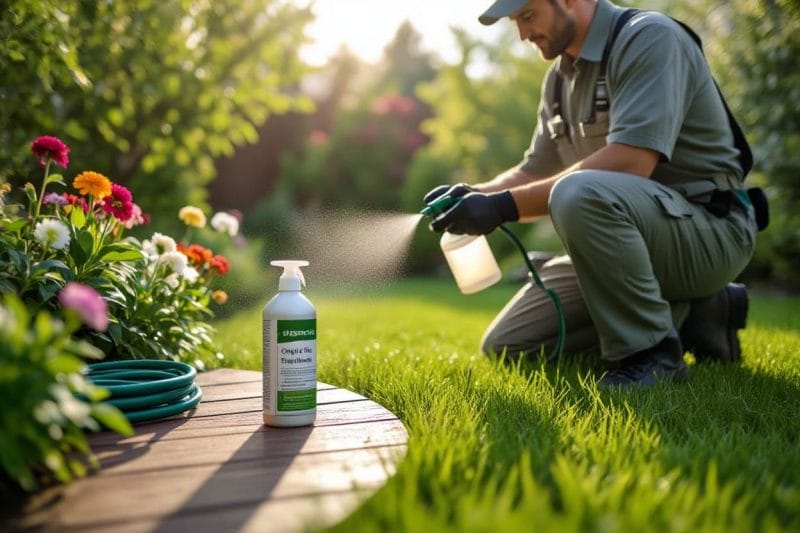Pestcontrol in your yard is important to protect your family and pets from flea infestations that can cause discomfort and health issues. You need effective strategies to eliminate fleas and their eggs from your outdoor space, ensuring a safe, flea-free environment. In this post, you’ll learn practical steps to identify flea hotspots, use appropriate treatments, and maintain your yard to prevent future infestations. By following these guidelines, you can regain control of your yard and keep it comfortable and safe all year round.
Key Takeaways:
- Regularly mow the lawn and remove debris to reduce flea habitats and disrupt their life cycle.
- Use flea control products specifically designed for outdoor use, such as insect growth regulators or yard sprays, to effectively target fleas in various stages.
- Maintain pet flea treatments consistently to prevent re-infestation and reduce the spread of fleas from pets to the yard.
The Lifecycle of Fleas: Understanding Their Persistence
Fleas maintain their grip on your yard by cycling through four stages—egg, larva, pupa, and adult—each thriving in different microenvironments. Eggs drop off hosts into shaded soil or grass, while larvae feed on organic debris before spinning tough cocoons. Adults emerge primed to jump onto passing animals. This lifecycle can stretch over weeks to months, with pupae enduring harsh conditions until triggered by vibrations or carbon dioxide. Recognizing these phases reveals why fleas seem relentless, often lurking in wait for ideal conditions to reinfest your space.
Eggs, Larvae, and Adults: Breaking Down the Stages
Flea eggs, roughly 0.5mm and barely visible, scatter throughout your yard within 1-2 days after females lay them on pets. Larvae hatch in 2-14 days, avoiding light and burrowing into moist shaded areas while feeding on flea dirt and organic matter. Pupae can remain dormant for weeks or months inside cocoon-like cases. Adults then emerge, seeking warm-blooded hosts through carbon dioxide detection. This progression contributes to flea resilience and why interrupting multiple stages is imperative for your yard’s flea control plan.
Environmental Factors That Promote Flea Infestations
Temperatures between 70-85°F and relative humidity of 70% or higher accelerate flea development and survival. Shady, moist environments like tall grass, leaf litter, and pet resting areas provide ideal breeding grounds. Areas with frequent animal traffic facilitate egg dispersal and larval food supply. The following conditions exacerbate infestations:
- Warm seasonal changes fostering rapid lifecycle completion
- Undisturbed soil and organic debris accumulating flea eggs and larvae
- Limited sunlight and poor airflow encouraging cocoon survival
The combination enables flea populations to flourish unchecked without targeted yard treatments.
Fleas thrive where moisture accumulates beneath leaf piles, garden mulch, and dense undergrowth. Regular watering schedules that leave the soil damp for extended periods inadvertently fuel flea propagation. Wildlife such as rodents, raccoons, and feral cats introduce new fleas and sustain populations long after you treat pets. Microclimates created by natural shade and shelter can maintain optimal humidity crucial for larval development. The following environmental factors support this persistence:
- Prolonged soil moisture from irrigation or rainfall
- Accumulation of organic waste as larval food source
- Wildlife corridors facilitating continuous flea host access
The interplay of these variables creates hotspots in your yard requiring strategic targeting to break the flea cycle effectively.

Natural Solutions: Harnessing Eco-Friendly Methods
Addressing fleas in your yard without harsh chemicals becomes much easier with natural solutions that support your local ecosystem. Techniques such as introducing beneficial nematodes or using botanical extracts can disrupt flea life cycles while keeping beneficial insects safe. Leveraging these eco-friendly approaches often results in sustainable flea management, providing balance in your outdoor environment and minimizing potential risks to your pets and family.
Beneficial Nematodes and Their Role in Flea Control
Beneficial nematodes are microscopic roundworms that actively seek out flea larvae in your soil, penetrating and destroying them before they can mature. Applying nematodes during cooler, moist conditions maximizes their survival and effectiveness. These biological control agents naturally reduce flea populations without pesticides, complementing other yard treatments and maintaining soil health. Available from garden centers or online, they’re easy to apply with water and offer a targeted, non-toxic solution adaptable to various yard sizes.
Essential Oils: Nature’s Repellents Against Fleas
Essential oils like lavender, cedarwood, and peppermint have proven flea-repelling properties that help deter adult fleas from your yard. Diluting these oils in water and spraying areas where pets frequent or flea activity is noted establishes a protective barrier. Their volatile compounds disrupt fleas’ scent trails and reproductive behaviors, making your yard less attractive to them while providing a fragrant, natural alternative to synthetic insecticides.
Studies have shown that cedarwood oil, rich in natural compounds like cedrol, can reduce flea numbers by up to 89% when regularly applied to soil and vegetation. You can combine oils, such as mixing lavender with lemon eucalyptus, to enhance repellent efficacy. Always ensure proper dilution to avoid irritation for pets and apply during cool parts of the day to prevent rapid evaporation. These oils degrade quickly, ensuring minimal environmental impact while giving your yard an aromatic advantage against fleas.

Chemical Approaches: When to Consider Pesticides
If flea infestations persist despite regular yard cleanup and natural treatments, chemical pesticides may become necessary to regain control. You should consider pesticides when flea populations are dense in shaded, moist areas where pets frequently rest, or after rain, which can accelerate flea reproduction. Targeting larvae and adult fleas simultaneously is often key for effective control. Depending on the size of your yard and infestation severity, a professional treatment or carefully applied over-the-counter solutions can deliver faster relief compared to organic methods alone.
Selecting the Right Products for Yard Treatment
Choosing pesticides labeled specifically for outdoor yard use ensures safety and efficacy. Look for products containing insect growth regulators (IGRs) like methoprene or pyriproxyfen, which disrupt flea life cycles, paired with adulticides such as bifenthrin or deltamethrin. Avoid general household insecticides not intended for outdoor use to minimize environmental impact. Checking EPA registration and reading customer reviews can help identify products with proven flea eradication performance in similar climates and yard types.
Safe Application Techniques to Protect Your Pets and Family
Applying flea pesticides with precision reduces exposure risks to children and pets. Focus treatments on shaded, grassy areas where fleas hide rather than bare soil. Wearing gloves and using a handheld sprayer with adjustable nozzles enhances control over application rates and coverage. After spraying, keep pets and family away from treated zones until surfaces dry completely, typically 2 to 4 hours depending on product instructions and weather conditions.
To further safeguard your loved ones, store pesticides securely out of reach and dispose of empty containers according to local hazardous waste guidelines. Timing your application during early morning or late evening when pets are less active outdoors can minimize contact. Incorporating water-based formulations often decreases airborne particles, reducing inhalation risks. Additionally, rinse any pet equipment or toys that may contact treated soil to prevent ingestion of residual chemicals.

Preventative Measures: Keeping Your Yard Flea-Free Long-Term
Maintaining a flea-free yard requires ongoing attention to environmental and behavioral factors that influence flea populations. Incorporating consistent preventative strategies like landscaping adaptations and routine upkeep will reduce the chances of fleas returning. Integrating physical barriers, proper drainage, and pet hygiene into your yard care routine elevates your defense against infestations over time. These layered actions create an environment less hospitable to fleas while supporting your overall outdoor space’s health.
Landscaping Choices to Deter Fleas
Select plants and landscaping materials that discourage fleas by limiting shaded, moist areas where they thrive. You might choose sun-loving grass species that dry quickly after rain, minimizing flea habitat. Avoid dense shrubs and leaf litter buildup which flea larvae prefer. Ground covers like lavender, eucalyptus, or rosemary emit natural repellents, adding a biological layer of flea deterrence. Stone pathways or mulch beds can reduce soil moisture and flea survival rates when strategically placed.
Regular Maintenance Practices for Ongoing Protection
Frequent yard maintenance disrupts flea life cycles effectively. You can mow grass weekly to under 3 inches, remove fallen leaves promptly, and keep lawn edges clean from organic debris. This eliminates shaded, humid microhabitats fleas use to breed. Applying beneficial nematodes in early spring also helps control flea larvae biologically, reducing pesticide reliance. Maintaining proper drainage prevents puddling, another flea-attracting condition.
Digging deeper, regular maintenance extends beyond merely cutting grass or leaf removal. Monitoring moisture levels with well-drained soil and scheduling nematode applications during peak flea breeding seasons—typically spring and fall—optimizes control. Combining mechanical disturbance with targeted biological treatments continuously interrupts flea development stages, minimizing rebound infestations. Consistency in these practices can lower flea presence by over 70%, ensuring your yard stays mostly hostile to flea survival year-round.
Expert Insights: Perspectives from Pest Control Professionals
Pest control professionals often emphasize that effective flea control in your yard hinges on a multipronged approach rather than a single treatment. They note that flea eggs and pupae can remain dormant for months, so repeated interventions timed with the flea life cycle are important. Professionals advise integrating environmental modifications—such as reducing shaded, humid spots—with targeted insecticides. According to one expert, outdoor treatments typically require follow-ups every 7–10 days for at least a month. You’ll find their strategies rely heavily on understanding flea biology and using data-driven timing to disrupt infestations reliably.
Common Misconceptions About Flea Control
A widespread myth is that treating pets alone is enough to eliminate yard fleas, but ignoring the outdoor environment allows the cycle to continue unchecked. Another misconception involves believing that a single pesticide application will permanently solve issues; flea pupae can survive treatments and hatch later, so persistent effort is necessary. Many also assume fleas only reside on animals, yet they thrive in shaded, moist areas of your yard. Combating these false beliefs can help you manage flea populations more effectively and avoid futile efforts that waste time and resources.
Essential Tips from the Field
Field specialists recommend maintaining the landscape by regularly mowing, removing leaf litter, and trimming dense vegetation to reduce flea-friendly habitats. Application timing is key—treating during warmer months when fleas actively cycle through eggs and larvae amplifies control success. Using insect growth regulators alongside conventional insecticides can inhibit flea development stages, enhancing results. Recognizing flea hotspots, such as shaded yards or areas frequented by stray animals, allows you to focus treatments strategically rather than uniformly treating the entire property.
Delving deeper into expert advice, one method involves deploying nematodes, microscopic worms that prey on flea larvae, proving highly effective in moist soil conditions. Professionals also spot-treat areas where animals rest, especially under porches or decks, since flea populations cluster there. Rotating types of insecticides prevents resistance buildup, ensuring treatments remain potent over time. Consistent monitoring after initial treatment rounds enables timely interventions, and combining mechanical, biological, and chemical tactics creates a robust defense against fleas. Recognizing these layered approaches can elevate your flea control strategy far beyond simple sprays or pet-first methods.
- Regularly mow and clear yard debris to deprive fleas of ideal breeding grounds
- Apply treatments during peak flea activity in warm months for maximum impact
- Use insect growth regulators with insecticides to disrupt flea life cycles
- Spot-treat common flea harborage zones like shaded areas and pet resting spots
- Rotate insecticides to prevent resistance and maintain control efficacy
- Recognizing flea hotspots supports precise, efficient application of control measures
Final Words
Conclusively, to effectively get rid of fleas in your yard, you need to adopt a consistent approach that includes proper yard maintenance, targeted treatments, and preventative measures. By regularly mowing, removing debris, and applying safe insecticides or natural remedies, you reduce flea populations and protect your outdoor space. Additionally, treating your pets and monitoring the environment helps prevent reinfestation. Taking these proactive steps ensures your yard remains a comfortable and flea-free area for both you and your pets to enjoy.
FAQ
Q: What is the first step to take when trying to get rid of fleas in the yard?
A: The first step is to thoroughly clean the yard by removing debris such as leaves, grass clippings, and pet waste. Fleas and their larvae thrive in moist, shaded areas with organic matter, so keeping the yard tidy reduces their habitat and helps control their population.
Q: Can natural remedies be effective in eliminating fleas from outdoor areas?
A: Yes, natural remedies like diatomaceous earth, beneficial nematodes, and certain important oils can help reduce flea populations. Diatomaceous earth works by drying out and killing fleas, while beneficial nematodes are microscopic worms that feed on flea larvae. Essential oils such as cedarwood or lavender can repel fleas but should be used with caution around pets and plants.
Q: How often should flea treatments be applied in the yard?
A: Treatment frequency depends on the product used and the severity of the flea infestation. Generally, yard treatments should be repeated every 2 to 4 weeks until flea activity significantly decreases. Following the manufacturer’s instructions on insecticide labels will ensure proper timing and effectiveness.
Q: Is it necessary to treat pets at the same time as the yard for flea control?
A: Yes, treating pets concurrently is important because fleas often move between pets and their environment. Using appropriate flea preventatives on pets in combination with yard treatments helps break the flea life cycle, minimizing reinfestation risk.
Q: What role does lawn care play in flea prevention?
A: Proper lawn care, including regular mowing, watering, and removing excess moisture, can make the environment less hospitable for fleas. Fleas thrive in moist, shaded conditions, so maintaining a dry and sunny yard limits their ability to survive and reproduce.
Q: Are chemical insecticides safe to use in the yard, and what precautions should be taken?
A: Chemical insecticides can be effective but must be used carefully to ensure safety for humans, pets, and beneficial insects. Always follow the product’s directions, avoid over-application, and keep children and pets away from treated areas until it is safe. Consider using targeted treatments and opting for environmentally friendly options when possible.
Q: How long does it typically take to completely eliminate fleas from the yard?
A: Eliminating fleas from the yard often requires several weeks of consistent treatment since flea eggs, larvae, and pupae develop at different stages. It usually takes about 4 to 8 weeks to break the flea life cycle and see a significant reduction, especially when combining yard treatments, pet care, and environmental management.









